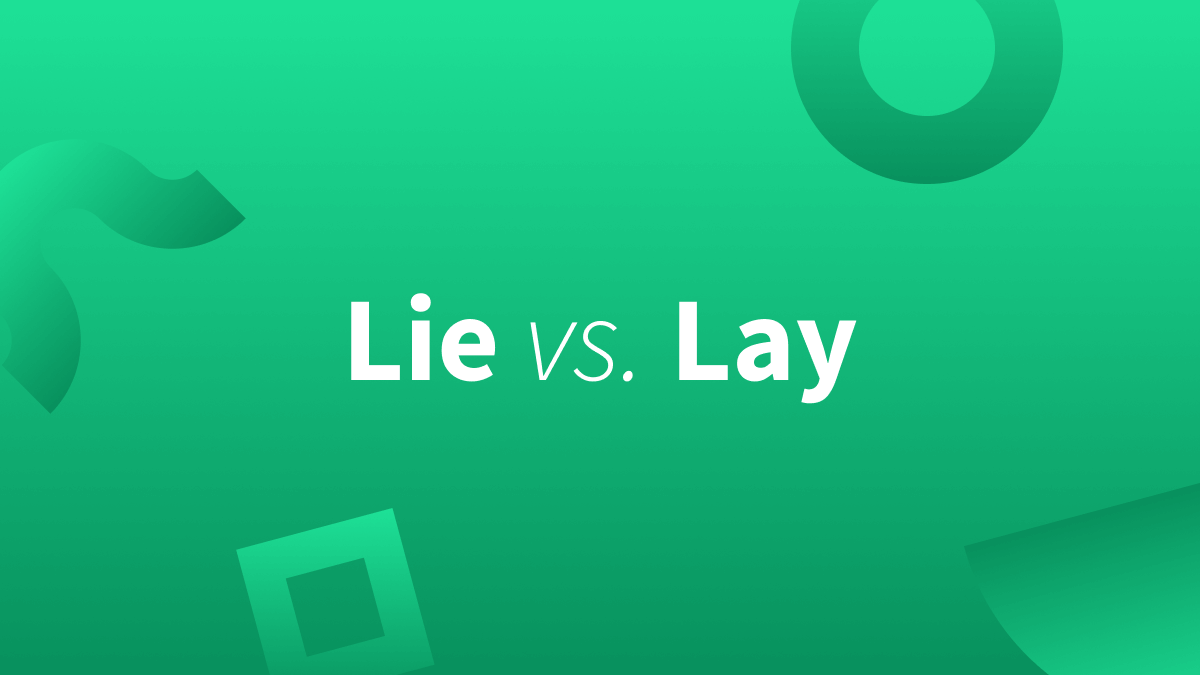- Lay is commonly used as a verb that means “to place something down flat,” and requires an object.
- Lie has a few definitions, and one of them is “to be in a flat position on a surface.” In this sense, lie does not require an object.
- Conjugating these verbs in other tenses is especially challenging. For example, the past tense of lie is lay.
- ○ Go lay that sheet on the bed.
- ○ I’m going to lie down after you put the sheet on the bed.
- ○ Last night, he lay down to sleep at 8 PM.
Understanding “Lay” and “Lie”
After a long day of work, all you want to do is go home and… lay down or lie down?
The answer is lie down.
There’s a lot to cover when it comes to using the verbs lay and lie correctly. One of the most notable differences you should be aware of is that lay is a transitive verb, meaning it requires an object that receives the action. Without the object, the sentence would not make sense (grammatically speaking). Just to refresh your memory, an object is a noun that receives the action of a verb.
I will lay the sheet outside on the grass.
Then we can lie down on it to watch the clouds go by.
While lay needs an object (the sheet) to receive the action (lay), the verb lie is an intransitive verb and therefore doesn't require an object to receive/realize the action.
Yes, learning the difference between lay and lie can be a challenge, especially if you go beyond using them in the present tense. Below, we’re going to explain how to use lay and lie correctly in various tenses.
How To Use “Lay” Correctly
Lay is pronounced similarly to say and can function as a verb that means “to put something down flat.”
Will you lay this tablecloth over the table, please?
It’s a tradition to lay wreaths on the graves of your loved ones.
Let’s lay this blanket down on the grass so we can have a picnic.
Lay is in the present tense form. But what about the other tenses? The past tense and past participle of lay is laid.
Last night, I laid the baby down to sleep last night at 8:00 PM.
I laid the products on the blanket so that everyone could see what I was selling.
Joanna has laid everything out clearly.
My hen has laid countless eggs ever since I built her a safer, more comfortable hen house.
The progressive form of lay is laying.
I am laying the outfits down on the bed so that the girls can get dressed on their own.
Things get a little trickier when trying to understand that past tense of lie. We’ll explain below.
How To Use “Lie” Correctly
Lie has similar pronunciation to the “line” in recline (which can help you remember what it means) and also has a few different definitions. As a verb, lie can mean “to be or put yourself in a flat position on a surface.”
I’m gonna go lie on that beach towel.
If you’re tired, you can lie down on my bed and rest.
Do you want to lie here and sleep while I go run errands?
These examples are all in the present tense. It’s a little more confusing when you conjugate lie to past tense, or when you use the past participle. The past tense of lie is lay, whereas the past participle is lain.
Yesterday, I lay on that beach towel until I got a sunburn.
He was tired last night, so he lay on my bed and rested.
Joseph has lain there for hours.
I have lain on the grass and observed insects before.
However, lie can also be used as a noun that means “untruth” or a verb that means “to tell an intentionally false statement.” When used as a verb, the past tense and past participle of lie is lied.
We knew that what he said was a lie.
My mom promised she wouldn’t ground me so long as I didn’t lie.
I lied once before, and I didn’t like the way it made me feel.
My brother has lied plenty of times before and has always gotten caught.
The progressive form of both versions of the verb lie is lying.
I am lying in bed right now.
Derrick is lying about the grade he received on the exam.
Now You Know How To Use “Lay” and “Lie”
Yes, that was a lot to follow. Here are the key points that’ll help you remember the difference between lay and lie.
- Lay is a transitive verb and therefore requires an object, and means “to place something down in a flat position.”
- The past tense and past participle of lay are laid.
- Lie does not require an object, and it means “to be in a flat position on a surface” (recline). The past tense and past participle of this lie are lay and lain.
- Lie can also be used as a verb that means “to tell an untruth.” The past tense and past participle of this version are lied.
LanguageTool can help ensure you use the correct verb. Additionally, this multilingual text editor can correct other common mistakes and typos to ensure your writing is flawless.

